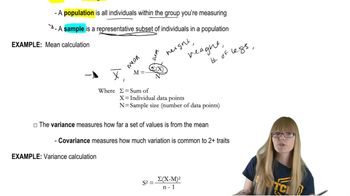Describe the various characteristics of the Watson–Crick double-helix model for DNA.
Table of contents
- 1. Introduction to Genetics51m
- 2. Mendel's Laws of Inheritance3h 37m
- 3. Extensions to Mendelian Inheritance2h 41m
- 4. Genetic Mapping and Linkage2h 28m
- 5. Genetics of Bacteria and Viruses1h 21m
- 6. Chromosomal Variation1h 48m
- 7. DNA and Chromosome Structure56m
- 8. DNA Replication1h 10m
- 9. Mitosis and Meiosis1h 34m
- 10. Transcription1h 0m
- 11. Translation58m
- 12. Gene Regulation in Prokaryotes1h 19m
- 13. Gene Regulation in Eukaryotes44m
- 14. Genetic Control of Development44m
- 15. Genomes and Genomics1h 50m
- 16. Transposable Elements47m
- 17. Mutation, Repair, and Recombination1h 6m
- 18. Molecular Genetic Tools19m
- 19. Cancer Genetics29m
- 20. Quantitative Genetics1h 26m
- 21. Population Genetics50m
- 22. Evolutionary Genetics29m
7. DNA and Chromosome Structure
DNA as the Genetic Material
Problem 22
Textbook Question
What is the hyperchromic effect? How is it measured? What does Tₘ imply?
 Verified step by step guidance
Verified step by step guidance1
Understand that the hyperchromic effect refers to the increase in UV absorbance of DNA when it transitions from double-stranded to single-stranded form due to the disruption of hydrogen bonds between base pairs.
Recognize that this effect is measured by monitoring the absorbance of DNA at 260 nm using a spectrophotometer as the temperature gradually increases, causing DNA denaturation (melting).
Plot the absorbance at 260 nm against temperature to obtain a melting curve, which shows a characteristic sigmoidal increase in absorbance as DNA strands separate.
Identify the melting temperature, denoted as \(T_{m}\), as the temperature at which half of the DNA molecules are in the single-stranded state and half remain double-stranded; it corresponds to the midpoint of the hyperchromic transition on the melting curve.
Interpret \(T_{m}\) as an indicator of DNA stability, where a higher \(T_{m}\) suggests stronger base pairing and greater DNA duplex stability, often influenced by GC content and ionic conditions.
 Verified video answer for a similar problem:
Verified video answer for a similar problem:This video solution was recommended by our tutors as helpful for the problem above
Video duration:
2mPlay a video:
Was this helpful?
Key Concepts
Here are the essential concepts you must grasp in order to answer the question correctly.
Hyperchromic Effect
The hyperchromic effect refers to the increase in UV absorbance of nucleic acids, especially DNA, when the double-stranded structure denatures into single strands. This occurs because single-stranded DNA absorbs more UV light at 260 nm due to the unstacking of bases, which increases their exposure to UV radiation.
Recommended video:
Guided course

Maternal Effect
Measurement of the Hyperchromic Effect
The hyperchromic effect is measured by monitoring the absorbance of DNA at 260 nm using a spectrophotometer as the temperature increases. The absorbance rises sharply at the melting point, indicating the transition from double-stranded to single-stranded DNA, which reflects DNA denaturation.
Recommended video:
Guided course

Mathematical Measurements
Melting Temperature (Tₘ)
Tₘ is the temperature at which half of the DNA molecules in a sample are denatured, meaning 50% of the double-stranded DNA has become single-stranded. It is an important indicator of DNA stability and depends on factors like GC content, ionic strength, and DNA length.
Recommended video:
Guided course

Mutations and Phenotypes

 9:32m
9:32mWatch next
Master History and Experiments with a bite sized video explanation from Kylia
Start learningRelated Videos
Related Practice
Textbook Question
726
views
